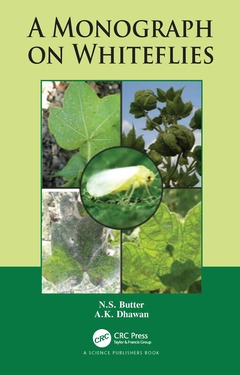Description
A Monograph on Whiteflies
Authors: Butter N.S., Dhawan A.K.
Language: English
Subjects for A Monograph on Whiteflies:
Keywords
Whiteflies and biology/ecology; Host plant resistance; Management tactics; Pest resurgence; Pesticide resistance; Damage potential; Feeding mechanism; Taxonomic status; Bemisia Tabaci; Trialeurodes Vaporariorum; Tomato Yellow Leaf Curl Virus; Whitefly Population; Middle East Asia Minor; Yellow Sticky Traps; Entomopathogenic Fungi; Encarsia Formosa; Neem Oil; Leaf Curl Virus; Beauveria Bassiana; Bemisia Argentifolii; ToLCV; Sweet Potato Whitefly; Cotton Whitefly; Tamil Nadu; IGR; Whitefly Species; Amblyseius Swirskii; Metarhizium Anisopliae; Whitefly Bemisia Tabaci; Mitochondrial Cytochrome Oxidase; Gossypium Arboreum; Whitefly Adults; Helicoverpa Armigera
Publication date: 01-2024
· 15.6x23.4 cm · Paperback
Publication date: 10-2021
· 15.6x23.4 cm · Hardback
Description
/li>Contents
/li>Biography
/li>
In all, 1550 species of whiteflies have been identified. The rapid spread of Bemisia tabaci has occurred throughout the globe and it is regarded as the most notorious species. It is a complex species known to contain many biotypes namely, New World (Biotype -A), B-biotype MEAM1 (Biotype-B or Bemisia argentifolii, and MED (Biotype-Q) depending upon the geographical location. The complete information on the bio-ecology of important species along with the feeding mechanism has been presented in this book. The use of modern techniques of identification has added more biotypes considering the variations in host range, species of endosymbionts, virus transmission efficiency, and resistance to pesticides. The resistance and resurgence due to pesticides has been discussed in the monograph. The information on economic thresholds for judicious use of pesticides or release of natural enemies against whiteflies has been quoted in this compilation The pest control methods, namely chemical, cultural measures, biocontrol agents, resistant varieties, and mechanical devices have been elaborated on. Based on the availability of information the integrated model has been suggested to contain the whitefly menace under different situations. Considering the key factors responsible for the outbreak of whiteflies, a sound system of IPM has been formulated. The book also contains the use of semiochemicals and biotechnological tools likely to gain momentum in the future.
1. Introduction, Identification, and Feeding Mechanism 2. Bioecology and the Extent of Damage 3. Taxonomic Status, Biotypes, and Endosymbionts 4. Population Sampling and Economic Thresholds 5. Pesticides—Resistance and Resurgence 6. Host Plant Resistance 7. Natural Enemy Complex, Entomopathogenic Organisms, and Botanicals 8. Insect Behavior Alteration Approaches 9. Mechanical and Physical Measures 10. Cultural Measures 11. Non-Chemical Measures 12. Weather Parameters and Forecasting Models 13. Vector of Plant Viruses 14. Management Strategies
N.S. Butter was born to a rural family in a small village, Hakam Singh Wala, District Bathinda, Punjab, India on 13 October 1948. After attaining his school education in 1967, he joined the Punjab Agricultural University, Ludhiana, and obtained his BSc (Agriculture) in 1971, MSc (Entomology) in 1973, and Ph.D. (Entomology) degrees in 1976. Being a meritorious student, he won a merit scholarship for his bachelor’s and master’s degrees and was awarded the Senior Fellowship, Council of Scientific and Industrial Research during his Ph.D., which was converted into a post-doctorate fellowship after the completion of his doctorate in 26 November 1976. Dr. N.S. Butter served in this position up till 23 February 1977. The fellowship was relinquished on taking on the post of Assistant Entomologist where he continued to work till 30 June 1987. Dr. Butter got promoted as Entomologist (Cotton) and continued to work in that post till 30 March 1994. Dr. Butter was selected as Professor of Plant Protection and joined that post on 31 March 1994, after which he was elevated to the post of Head, Department Entomology on 20 June 2006, where he discharged the administrative duties till his superannuation on 31 October 2008. During this period, Dr. Butter worked on cotton insect pests and made several recommendations for their management, guided nine postgraduate students in entomology, and taught both under-graduate and post-graduate courses in entomology, delivered special lectures in seminars/symposia, delivered forty-two TV/radio talks on pest management, established a plant clinic at the university level (this model was emulated in the country). Dr. Butter has published 250 papers, including 85 research papers extension articles, books, book chapters, review articles in journals of repute to his credit. Dr. Butter is a Fellow of the Entomological Society of India and the Indian society for the Advancement of Insect Science. As an administrator, he has organized
These books may interest you

Polyphagous Pests of Crops 242.64 €



